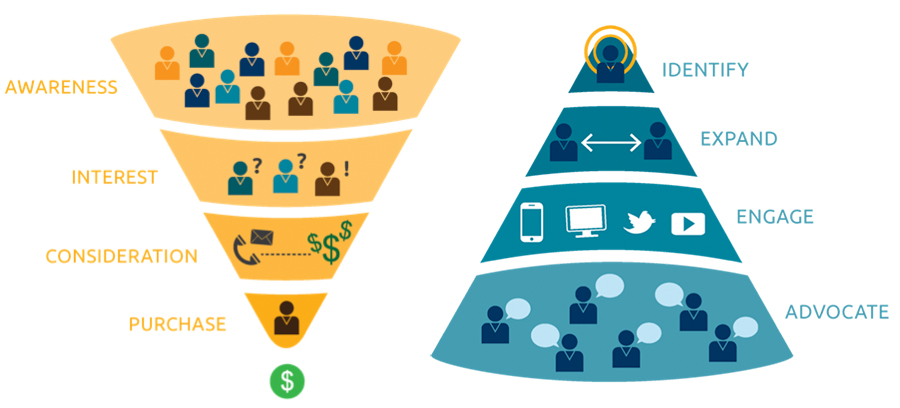
In the Business to Business world, there’s a ton of opportunity. But with opportunity comes competition. So how can you stand out in a cluttered B2B climate? The answer is Account Based Marketing.
What is Account Based Marketing?
Account Based Marketing (ABM) focuses resources and efforts on a targeted set of accounts that matter most for the business, instead of covering a broad range of potential customers. This increases the likelihood of converting prospects to sales when compared to standard lead-focused models alone.
Account Based Marketing practices traditional and proven B2B principles, but targets company accounts rather than individual sales leads.
Struggles with Traditional B2B Advertising
For any given B2B sale, 7-20 people are involved in the decision-making process, and 34% of B2B buyers have increased the number of stakeholders involved in the purchase process. This means you need to reach and convince more people that your product or service is the best fit for their needs.
B2B buyers don’t contact suppliers directly until 57% of the purchase process is complete, and 94% of B2B buyers conduct some form of online research before buying a business product. Also, it’s estimated by 2020, 80% of the buying process will occur without any direct human-to-human interaction.
Buyers are savvy and they don’t want to talk to you until they’re convinced your product or service may be able to help them.
So, how do you get in front of these buyers?
How Account Based Marketing Works
In Account Based Marketing, it’s common to hear the phrase “Flip the Funnel.” We all know the premise behind the traditional sales process: We start with a ton of leads. As those leads move down the magical funnel, they become more qualified. The most qualified leads become sales qualified leads. Then BOOM! A sale.
Well, in Account Based Marketing, the funnel is flipped.

Below are the basic steps of ABM.
Identify the Best Fit Accounts
Find the right companies so resources aren’t used on prospects that will not become customers. Your marketing and sales teams must collaborate on a list of target accounts, or the companies that are the best fit for your solution. You need to identify your “ideal client” and identify specific companies that fit those criteria.
Expand Contacts Within an Account
Identify personas of the people within the accounts you would like to target. You will need to deliver different messages and creative to different personas because they may be looking for different things when determining whether to partner with your company.
Engage Accounts
Next is to engage the contacts on the channels where they’re most active using messaging and content that’s valuable to them. The CEO is most likely looking for something different than the Director of IT or CFO. Craft content that’s relevant to each persona and provide that information when it’s most valuable to them.
Create Advocates
Above we mentioned that sometimes 20 or more people are involved in the decision-making process. This means you cannot simply target a single decision maker. There are many people inside the business that you need to convince. By targeting and creating internal advocates, your messages can resonate much further than you could ever achieve on your own.
Measure Success
With Account Based Marketing, measurement focuses on performance indicators that evaluate success at the account level. You can report on reach, impressions, clicks, and media spend by account to report on advertising’s influence on target accounts. But you can also go deeper than that.
Here are other KPIs you should report on in your ABM efforts:
- Marketing Qualified Accounts – With ABM, you’ll shift from marketing qualified leads (MQLs) to marketing qualified accounts (MQAs), which provide a much more comprehensive picture.
- Engagement Rate – Look at whether accounts are clicking on ads, have a high-velocity score, or are visiting your website.
- Reach Within an Account – How many new contacts did you reach with your ABM campaign? This is a great indicator of account brand awareness.
- Pipeline Velocity – Did your ABM campaign move accounts through your sales process faster and did you close deals faster?
- Conversion Rates Throughout the Funnel – This can be measured by many different parameters depending on the stage of the sales process and your business goals. Some common goals to track include meetings set, opportunities created, and target accounts converted to customers.
- ROI – What is the return on your investment for each account-based marketing campaign?
Go Beyond What You Can See
There are, hopefully, many people coming to your website every day. Many of these people are “invisible” because they don’t fill out a form, call, or request to be contacted. You need to be able to see who’s viewing your website because it can be a direct result of current ABM efforts or you can identify potential leads.
Google Analytics reports on how many people visit your website, but IP intelligence platforms tell you “who” is visiting your website. These platforms use the visitor’s IP address to scrub relevant information about that individual from the internet. Creepy, right?
IP intelligence platforms won’t tell you the name of the person viewing your site, but it will tell you where the person works and a bunch of information about that company.
Account Based Marketing is a complex, in-depth process that usually requires a fair amount of setup in the beginning. However, in return, you’ll have less wasted marketing spend and the efforts can generate 97% higher ROI than other marketing activities.
If you have questions about ABM or digital marketing in general, don’t hesitate to reach out. We would love to help!